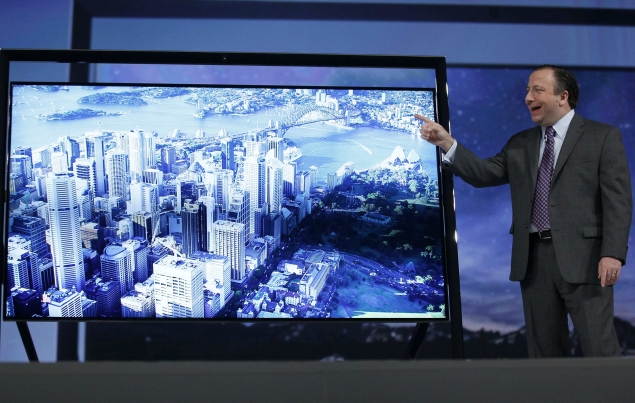Samsung's Sharp deal indicates worries about own display unit

Cross-town rival LG Display Co Ltd overtook Samsung's display unit last year as the world's top maker of liquid crystal displays.
LG Electronics Inc, an affiliate of the display company, has beat Samsung to market with a TV using a new technology thin, bright organic light-emitting diode (OLED) screens on which Samsung has staked its future in the display business.
And even Japan's Sharp Corp, which had to be bailed out by its banks last autumn and which Samsung has now taken on as a partner, has pulled into the lead in some of the latest LCD production and thin-screen technology.
Samsung's modest $111 million investment in Sharp, announced on Wednesday, will thus not only give it access to the Japanese company's technology, it will turn up the heat on its own display unit that many analysts say has some catching up to do.
"It's a warning message in a sense that Samsung is sending to Samsung Display," said an industry analyst with a top four-star rating from Thomson Reuters StarMine, who declined to be named because of the sensitivity of the subject.
Symbolic stake
The latest deal, which will give Samsung a symbolic 3 percent stake in Sharp, is a drop in the bucket from the South Korean goliath's 37.4 trillion won in cash.
But it will give Samsung a broader supplier base, access to Sharp's low-cost thin-screen technology, and a foot in the door at one of Apple Inc's key Asian display suppliers.
The need for this sort of tie-up marks an unusual departure for the ascendant technology company, heralded for aggressive management that allowed it to leapfrog past Japanese giants such as Sony Corp and Toshiba Corp in markets from consumer electronics to semiconductors.
Samsung's $230 billion market capitalisation is more than six times the combined value of Japan's top three TV makers -Sony, Sharp and Panasonic Corp.
One possible impetus for the equity deal, Samsung's first with a major Japanese electronics company, could be faltering screen orders from Apple, which is both a major customer and its main competitor in the global smartphone market.
Sharp is Apple's second-largest display supplier, according to industry analysts and research firms. Apple itself does not reveal information about its suppliers.
But the bigger issue for Samsung will be ensuring its OLED screen development efforts are on track.
Samsung's strategic shift to OLED technology was spurred in part by the roaring success of its Galaxy smartphones, which featured the bright, power-saving displays and propelled Samsung into the No.1 spot last year in the world smartphone market.
Samsung now holds a near monopoly in the production of small, smartphone-sized OLED displays, which it produces at the rate of nearly half a million a day, garnering double-digit profit margins.
Samsung has struggled to produce televisions using OLED screens, however, as it stuck with the conventional RGB form of the technology that is difficult to scale to large glass sizes.
LG has opted for white OLED technology that uses a cheaper, maskless manufacturing method with a lower error rate and higher productivity, although some experts say it loses some of the colour brightness that has made OLED a promising frontier for TV makers.
Premium product
Samsung, which tore apart a Sony TV in the 1970s to learn new technologies, ended Japan's three-decade reign at the top of the TV market in 2006 and has since enjoyed healthy profit margins while its Japanese rivals bleed record amounts of red ink.
Its success was fed in large part by the aggressive launch of new technologies such as Internet-enabled TV sets and LCD TVs backlit with power-saving light-emitting diodes.
OLED TVs, which LG sells for more than $10,000 for a 55-inch model, were supposed to be the next premium product to prop up margins as the global TV market stagnates in a weak economy.
But the delay in Samsung's OLED models have forced it to seek its next big boost from ultra-definition television, which others have been pursuing with LCDs - where Samsung now lags.
"With the (OLED) project pushed back Samsung instead plans to lead the high-end market through over-60-inch UD TVs, which are becoming popular," said Peter Yu, an analyst at BNP Paribas.
That's where Sharp enters the picture.
Sharp has the world's only so-called 10th-generation display factory, which uses bigger sheets of glass that, at 3 metres square, can be cut into eight 60-inch panels for large TV screens. That's far more efficient than eighth-generation plants that analysts say yield only three 60-inch screens per sheet.
Samsung Display's main LCD TV screen plants are seventh and eighth generation, suitable for 40 to 60 inch screens. It has held off on investing in larger panels given its strategic move into OLEDs, which are thin enough to bend or roll like paper, paving the way eventually for wearable computers and curved-screen TVs.
"I believe Samsung's big push for OLED is the right decision, given all the benefits OLED has over LCD, but overpromise and underdelivery caused a bit of hiccup here," said Lee Sun-tae, an analyst at NH Investment & Securities. He saw the Sharp deal as a way to help keep Samsung in the game until OLED is on board.
"This is definitely a good deal, as it allows Samsung to add large screen capacity at just a fraction of the cost of building a 10G plant. Samsung seized the right opportunity from Sharp's financial difficulty."
© Thomson Reuters 2013
Get your daily dose of tech news, reviews, and insights, in under 80 characters on Gadgets 360 Turbo. Connect with fellow tech lovers on our Forum. Follow us on X, Facebook, WhatsApp, Threads and Google News for instant updates. Catch all the action on our YouTube channel.
Related Stories
- Samsung Galaxy Unpacked 2025
- ChatGPT
- Redmi Note 14 Pro+
- iPhone 16
- Apple Vision Pro
- Oneplus 12
- OnePlus Nord CE 3 Lite 5G
- iPhone 13
- Xiaomi 14 Pro
- Oppo Find N3
- Tecno Spark Go (2023)
- Realme V30
- Best Phones Under 25000
- Samsung Galaxy S24 Series
- Cryptocurrency
- iQoo 12
- Samsung Galaxy S24 Ultra
- Giottus
- Samsung Galaxy Z Flip 5
- Apple 'Scary Fast'
- Housefull 5
- GoPro Hero 12 Black Review
- Invincible Season 2
- JioGlass
- HD Ready TV
- Laptop Under 50000
- Smartwatch Under 10000
- Latest Mobile Phones
- Compare Phones
- Redmi Note 15 5G
- Redmi Note 15 Pro 5G
- Redmi Note 15 Pro+ 5G
- Lava Play Max
- Poco C85 5G
- Honor Magic 8 Lite
- Jolla Phone
- Realme P4x 5G
- Asus ProArt P16
- MacBook Pro 14-inch (M5, 2025)
- OnePlus Pad Go 2
- Poco Pad M1
- Just Corseca Skywatch Pro
- Honor Watch X5
- Acerpure Nitro Z Series 100-inch QLED TV
- Samsung 43 Inch LED Ultra HD (4K) Smart TV (UA43UE81AFULXL)
- Asus ROG Ally
- Nintendo Switch Lite
- Haier 1.6 Ton 5 Star Inverter Split AC (HSU19G-MZAID5BN-INV)
- Haier 1.6 Ton 5 Star Inverter Split AC (HSU19G-MZAIM5BN-INV)

















